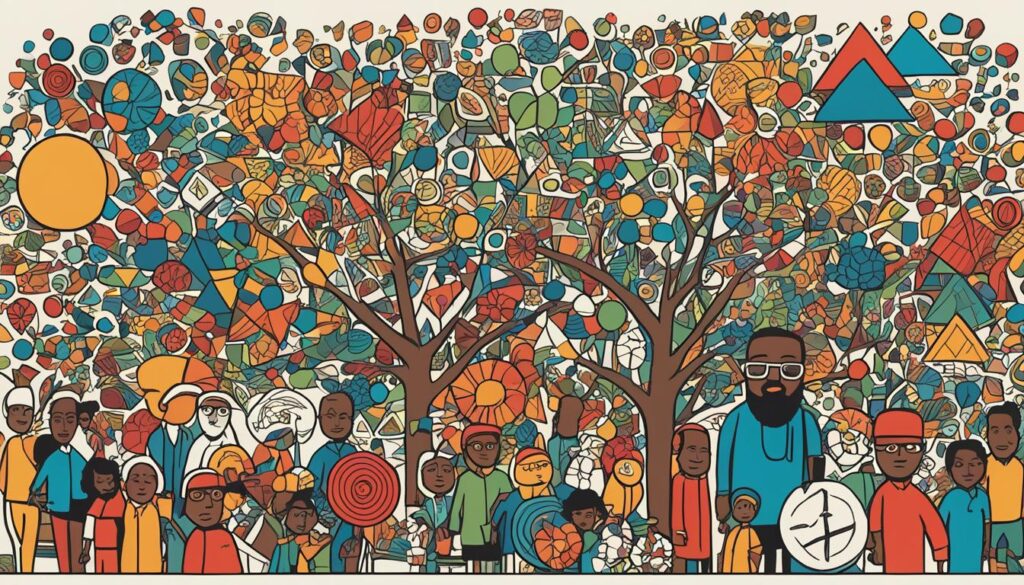In today’s society, we often hear about the issues of privilege, power, and difference. While these topics may seem complex and difficult to understand, Allan G. Johnson’s book “Privilege, Power, and Difference” offers a comprehensive analysis of these important issues and how they relate to social inequality.
Through vivid examples and thoughtful analysis, Johnson explores the ways in which privilege and power shape our society and perpetuate systems of oppression. Drawing on a wide range of disciplines, including sociology, psychology, and political science, he provides readers with an insightful and engaging examination of these critical issues.
Whether you are a student, educator, or simply interested in understanding the complexities of social inequality, “Privilege, Power, and Difference” is an essential read that offers valuable insights and perspectives.
Key Takeaways
- Johnson’s “Privilege, Power, and Difference” provides a comprehensive analysis of privilege, power, and difference.
- Through vivid examples and thoughtful analysis, Johnson explores the ways in which privilege and power shape our society and perpetuate systems of oppression.
- The book draws on a wide range of disciplines, including sociology, psychology, and political science.
- It is an essential read for anyone interested in understanding the complexities of social inequality.
- Readers will gain valuable insights and perspectives on critical issues related to social justice and equality.
Understanding Privilege and Power
Privilege and power are fundamental constructs that shape our society. Privilege refers to the advantages that people enjoy simply because of the social groups they belong to, such as race, gender, or economic status. Power, on the other hand, is the ability to control resources and make decisions that affect others.
In many cases, privilege and power go hand in hand. Those who hold power often use it to perpetuate their privilege and prevent others from gaining equal access to resources and opportunities. This creates a cycle of inequality that becomes self-perpetuating over time.
Understanding the dynamics of privilege and power is critical to addressing social inequality. It requires a recognition of the different forms that privilege can take and an acknowledgment of how those forms are reinforced through social institutions and cultural norms.
For example, in the United States, white people have historically held more privilege and power than people of color. This has been reinforced through systems such as redlining and mass incarceration, which have disproportionately impacted Black and Brown communities. In order to create a more equitable society, it is necessary to understand these systems of oppression and work to dismantle them.
Unpacking Social Identity
Social identity is a complex and multifaceted concept that encompasses various elements of a person’s identity, including race, gender, sexual orientation, age, and socioeconomic status. To truly understand social inequality, it is essential to unpack the various dimensions of social identity and how they intersect with privilege and power.
| Aspect of Social Identity | Privileged Group | Marginalized Group |
|---|---|---|
| Race | White | People of Color |
| Gender | Male | Female and Non-binary |
| Socioeconomic Status | Wealthy | Lower Income |
As the table illustrates, certain aspects of social identity come with inherent privileges while others mark individuals as marginalized within society. It is important to recognize the ways in which these identity markers shape our experiences and opportunities and to challenge systems of oppression that perpetuate inequality.
Systems of Oppression
Systems of oppression refer to the social structures and institutions that produce and maintain inequality through the systematic oppression of certain groups. Racism, sexism, and classism are all examples of such systems.
Racism is a system of oppression based on race, where people of color experience discrimination and limited opportunities due to their skin color. Sexism, on the other hand, is a system of oppression based on gender, where women and other gender minorities face discrimination and limited opportunities because of their gender identity. Classism is a system of oppression based on economic status, where those who are wealthy enjoy more privileges and opportunities compared to those who are not.
These systemic oppressions are often intertwined, with individuals facing multiple oppressions simultaneously. For example, women of color may experience both racism and sexism, which compound to create unique experiences of discrimination and inequality.
Understanding and analyzing these systems of oppression is crucial in achieving social justice, as it allows us to identify and challenge the structures and practices that perpetuate inequality.
Intersectionality: The Complexity of Inequality
Intersectionality refers to the interconnected nature of social categories, such as race, gender, and socioeconomic status, and how they overlap and interact with each other to create unique forms of discrimination and oppression. Understanding intersectionality is critical in comprehending the complexity of inequality, as it illuminates the ways in which power and privilege operate across multiple dimensions of our identities.
| Example: | Impact of Intersectionality |
|---|---|
 |
For instance, a person who identifies as a woman and is also a person of color may face discrimination and marginalization that is different from that experienced by a white woman or a person of color who identifies as male. This dynamic can result in compounding forms of disadvantage and oppression, and requires a deeper level of analysis to fully comprehend and address. |
The complexity of intersectionality challenges us to move beyond simplistic understandings of social inequality and work towards creating more inclusive and equitable systems that account for the multi-faceted dimensions of privilege and power in society.
The Role of Privilege in Society
In modern society, privilege plays a significant and often overlooked role in maintaining social inequality. Privilege can be defined as a set of unearned advantages that individuals or groups possess based on their social identity, such as race, gender, or class. These advantages can manifest themselves in various ways, including access to resources, opportunities, and power.
Those who possess privilege often remain unaware of its impact on society, as it is so deeply ingrained in our social structures and norms. However, when privilege goes unacknowledged, it perpetuates the marginalization of those who lack access to the same resources and opportunities. This can create a cycle of inequality that is difficult to break.
It is important to recognize the role privilege plays in perpetuating social inequality and work towards dismantling the systems that uphold it. This requires acknowledging one’s privilege and taking active steps towards advocating for marginalized groups. By working towards a more equitable society, we can create a world in which everyone has access to the resources and opportunities necessary for a fulfilling life.
Challenging Inequality: Allies and Advocacy
It’s not enough to recognize the existence of social inequality and privilege. We must also actively work to challenge these systems and promote equity and justice for all. One crucial way to do this is through allyship and advocacy. Allies are individuals who actively support and advocate for marginalized groups, while advocacy involves using one’s voice and resources to drive change.
The Importance of Allies and Advocacy
Allies and advocacy play a vital role in challenging social inequality. By standing in solidarity with marginalized communities and using their platforms to create change, allies and advocates can help amplify underrepresented voices and shift the balance of power towards equity. They can also help raise awareness about important issues, push for policy changes, and foster more inclusive and diverse communities.
Strategies for Challenging Inequality
There are various strategies that allies and advocates can use to challenge social inequality and promote justice. Some examples include:
- Listening to and learning from marginalized communities
- Using privilege and power to speak up and advocate for marginalized groups
- Engaging in difficult conversations with family, friends, and colleagues about privilege and oppression
- Supporting and amplifying underrepresented voices
- Pushing for policy changes at the individual and systemic levels
Building Inclusive Communities
In order to build inclusive communities, individuals and organizations must take intentional steps to address privilege, power, and difference. One key strategy is to prioritize diverse representation in leadership and decision-making positions. This can help ensure that a variety of perspectives are considered, and that power is not concentrated in the hands of a privileged few.
Another important step towards building inclusivity is to actively confront and address discriminatory behavior. This means creating policies and protocols for responding to incidents of prejudice or bias, and providing resources for education and training on issues of diversity and inclusion.
It is also crucial to center the voices and experiences of marginalized communities, and to prioritize their needs and concerns in community decision-making processes. This can involve creating spaces for community members to share stories and perspectives, and involving them in the development of policies and initiatives that impact their lives.

Ultimately, building inclusive communities requires ongoing commitment and effort from all members of the community. It means recognizing the ways in which privilege and power operate in our society, and actively working to dismantle these systems of oppression in order to create a more just and equitable world.
Implications and Future Directions
Recognizing privilege, power, and difference has significant implications for society. It can challenge existing power structures and contribute to greater equality and social justice. However, this process is not without its challenges and requires ongoing efforts from individuals and communities.
One potential future direction for achieving greater equality is through education and awareness. By educating individuals on the history and impact of social inequality, we can begin to shift attitudes and behaviors towards greater inclusivity. This includes not only educating individuals from marginalized groups, but also those who benefit from privilege and power.
Another possible direction is through policy change. This includes creating and enforcing anti-discrimination laws, as well as implementing affirmative action and other policies to promote diversity and inclusion.
It is important to note that achieving greater equality is a complex and ongoing process that requires sustained efforts. As we continue to recognize and challenge privilege, power, and difference, we can make progress towards a more just and equitable society.
Conclusion
Privilege, Power, and Difference by Allan G. Johnson provides a comprehensive analysis of social inequality and the complex ways in which privilege and power shape our society. Through examining the intersections of social identity and the systems of oppression that perpetuate marginalization, Johnson offers a framework for understanding the multiple dimensions of inequality.
Recognizing the role of privilege in maintaining social hierarchies is crucial for creating more equitable and just communities. Allies and advocacy can play a significant role in challenging inequality, and building inclusive environments is essential for acknowledging and addressing privilege, power, and difference.
Moving forward, it is imperative to continue exploring the implications of recognizing privilege and power and actively working towards future directions that prioritize greater equality and social justice.



